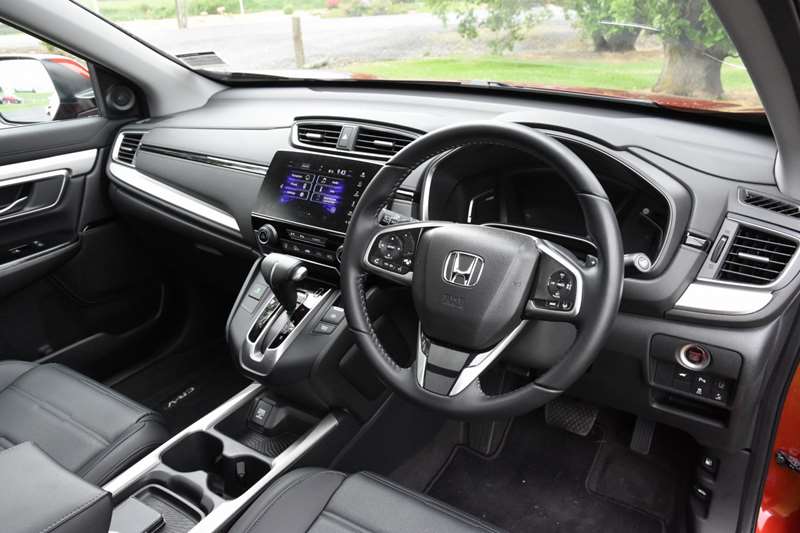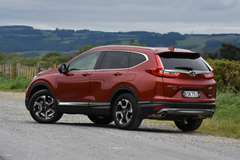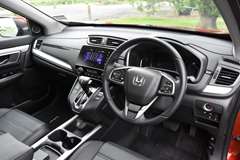| Price: | 47900 |
|---|---|
| Engine: | 1.5-litre turbocharged petrol four-cylinder, maximum power 140kW@5500rpm, maximum torque 240Nm@2000-5000rpm |
| Transmission: | Seven-step G-Shift CVT, all-wheel drive |
| Brakes and stability systems: | Front and rear disc brakes, ABS, VSC, EBD |
| Safety: | Five-star NCAP |
| Wheels and tyres: | Alloy wheels, 235/60 R18 tyres |
| Fuel and economy: | 91 Octane unleaded, 7.4 litres per 100km, tank capacity 57 litres |
| Emissions: | CO2 168g/km on combined cycle |
| Dimensions: | Length 4596mm, width 1855mm, height 1689mm |
Rating:
Overview
How fondly Honda must recall the pioneering days of the lifestyle sports utility vehicle. Back then - in the 1990s - early lifestyle SUV adopters had just two models to choose from: the Honda CR-V or the Toyota RAV-4. A quarter of a century on, SUVs of all shapes, sizes and types are massive business, but the battle for market share now involves a plethora of models, with every car-maker of significance in on the game.
While a return to its halcyon days of SUV dominance is an impossibility, Honda is certainly looking for the new CR-V to secure increased sales and market share.
To that end, and with the latest edition of smaller HR-V now doing a steady trade for Honda, this new (fifth-generation) CR-V is the largest and most powerful yet.It's also the first CR-V to be offered with a family-friendly third row of seats, although this seven-seater mode is only available in two-wheel-drive form. The variant supplied to Drivesouth for appraisal was the flagship all-wheel-drive variant. Called the AWD Sport Sensing, this range-topper lists at $47,900, which compares with $37,900 for the base model 2WD Touring, $40,700 for the AWD Touring and $44,900 for the seven-seater 2WD Sport.
Styling-wise, the CR-V strikes an classically elegant pose, augmented by some clever detailing of the bonnet, prominently flared rear wheel arches, and neat treatment of the front and rear lights.
This CR-V's dimensional stretch brings it closer size-wise to Mazda's CX-5, which is the current benchmark vehicle in the mid-size, mid- range SUV category. Unsurprisingly, the flagship CR-V has a spacious feel. Up front, driver and passenger sit on broad, supportive seats with plenty of room on either side and great forward and side visibility. The rear of the cabin also scores highly for space and comfort, with masses of head and leg room, decent shoulder room, a pair of adjustable air vents, and a broad fold-down centre armrest.
Contemporary connectivity needs are met by Bluetooth and a plethora of plug-in points, including an HDMI socket, four chargeable USB points and a 12-volt outlet in the centre bin. Echoing the exterior styling, the cabin has a fairly conservative look, albeit with a seven-inch centre touchscreen dominating the dashboard, and a fully-digital main instrument cluster.
Subtle strips of burnished metal and back plastic inserts provide the main constraint points, while soft-touch surfaces dominate on the dashboard and interior door panels. A power tailgate gives access to the boot. Remote release levers either side allow the 60:40 split rear seats to be folding down with the greatest of ease. With the seats fully stowed, carrying capacity (522 litres) more than doubles to 1084 litres.
Standard equipment across the new range includes keyless entry and start, satellite navigation, a noise-cancelling function that operates in conjunction with the audio system, Apple CarPlay and Android Auto connectivity, auto lights and wipers, and cruise control. A reversing camera and Honda's lanewatch side camera system are also fitted across the range, along with various driver assist functions and a warning system that provides an alert if it detects the driver is losing concentration.
The Sport Sensing version features a host of additional comfort and active safety items, including artificial leather trim, heated and power-adjustable front seats, and a double- length panorama sunroof. Extra safety features include adaptive radar cruise control, forward collision and land departure warning systems, lane-keeping assistance, a road departure mitigation systems, and auto-dipping headlights. Honda has taken the same mechanical route with the CR-V as has already been applied to the Civic, by downsizing to a 1.5 litre VTEC engine, in conjunction with a turbocharger.
But while the 1.5 litre engine is the same as that used on the Civic range, the CR-V has been fitted with a larger turbo to deliver more power and torque. Peak outputs are 140KW and 240Nm (the Civic musters 127kW and 220Nm), and these are delivered to the CR-V's fully automated four- wheel-drive system via a continuously variable transmission (CVT).
Fuel consumption is rated at 7.4l/100km on the standard economy cycle, while Drivesouth managed a reasonable 8.6l/100km return on a test programme that included a high proportion of stop-start city driving and hill work. Performance is solid enough, thanks in equal measure to maximum torque being available from just 2000rpm, and a seven-stage CVT transmission that is one of the best around.
Paddle-shift controls are fitted to the Sport Sensing variant too, and these came in handy when negotiating steeper hills. As noted above, the CR-V's four-wheel drive is entirely automated, with no selectable options to lock into permanent four-wheel drive, nor achieve any manual form of centre differential locking.
Instead, the CR-V's drive system engages four-wheel drive off the line to ensure maximum traction and - unless traction continues to be an issue - shifts to front-wheel drive once under way. This set-up confirms the CR-V as a ‘‘soft roader''.
That said, its 208mm of ground clearance is superior to almost all of its rivals. The presence of a full-sized spare tyre also marks the CR-V as better equipped for travel off the beaten track. Considering its dynamic abilities in tandem with the space and high-quality feel of its cabin, and this new machine is the most impressive CR-V in years.








